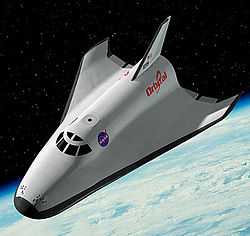Prometheus (spacecraft)

Prometheus was a proposed manned vertical-takeoff, horizontal-landing (VTHL) spaceplane concept put forward by Orbital Sciences Corporation in late 2010 as part of the second phase of NASA's Commercial Crew Development (CCDev) program.[1][2]
Design
The Prometheus design was based on an earlier NASA design, the HL-20 Personnel Launch System.[citation needed] Prometheus also included other NASA-funded design improvements to HL-20 by Orbital Sciences that were done some years ago as part of NASA's Orbital Space Plane program.[1] Whereas the HL-20 was a pure lifting body,[citation needed] the Prometheus design was for a Blended Lifting Body (BLB).[1] This design combines volumetric efficiency with superior aerodynamic qualities.[3] Prometheus could have initially carried four astronauts to the International Space Station or future commercial space stations but further development could have increased the seating capacity to six.[4] The baselined launch vehicle was the Atlas V, but the design could have accommodated other launch vehicles. The cost of the development of the Prometheus spacecraft and of upgrading the Atlas V would be between $3.5 and $4 billion.[5]
Commercial Crew Development program
Failing to be selected in NASA's CCDev phase 2 program, Orbital Sciences announced in April 2011 that they will likely wind down their efforts to develop a commercial crew vehicle.[6]
See also
- Dream Chaser (spacecraft) - another HL-20 derived proposed spacecraft put forward in 2010 by Sierra Nevada Corporation
References
- ↑ 1.0 1.1 1.2 "Orbital Submits Proposal for NASA's Commercial Crew Development Program". Press Release. Orbital Sciences Corporation. 2010-12-14. Retrieved 2011-02-06.
- ↑ "The Shape of Things to Come - Orbital’s Prometheus Space Plane Ready for NASA’s Commercial Crew Development Initiative".
- ↑ Leo, Ryan D. (2004-05-15). "Evolution of a Blended Lifting Body for the Orbital Space Plane". no. 3326. Society of Allied Weight Engineers. Retrieved 2011-02-28. "issues of volumetric efficiency, high L/D for cross range, low wing loading for reduced landing speed, and passive stability for all abort conditions were addressed. ... As the optimization process continued, the HL-20 initial reference shape eventually evolved into the Blended Lifting Body (BLB). The BLB combines volumetric efficiency with superior aerodynamic qualities and was designed to launch vertically and land horizontally."
- ↑ Wall, Mike (2011-02-09). "Proposed Private Space Plane Gets Fiery Name: Prometheus". Space.com. Retrieved 16 August 2011.
- ↑ Businesses Take Flight, With Help From NASA, New York Times, 2011-1-31, accessed 2011-02-28
- ↑ Orbital may wind down its commercial crew effort "Orbital may wind down its commercial crew effort". NewSpace Journal. 2011-04-22. Retrieved 2011-04-25. "CEO Dave Thompson said ... "I don’t, at this time, anticipate that we’ll continue to pursue our own project in that race. We’ll watch it and if an opportunity develops we may reconsider. But at this point, I would not anticipate a lot of activity on our part in the commercial crew market.""
External links
- A Blended Lifting Body Aerodynamic Design for the Orbital Space Plane, Henri D. Fuhrmann, AIAA-2003-3807, June 2003.
| ||||||||||||||||||||||
